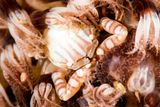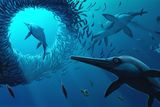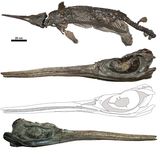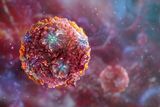New Deep-Sea Lanternshark and a Pearly White Crab Discovered Off the Australian Coast



NASA’s Jet Propulsion Laboratory will lay off 550 employees this week, the latest round of job cuts at the space science center.
The post More layoffs at JPL appeared first on SpaceNews.

(Houston) — Tory Bruno, president and CEO of United Launch Alliance, will be Honorary Chair of World Space Week 2026, it was announced today by World Space Week Association. Led by Bruno, […]
The post World Space Week Ends With A Big Announcement appeared first on SpaceNews.

Will China beat America in returning astronauts to the moon? We hear this question time and again. It is a perennial concern, both from a prestige and national security standpoint. But it is the wrong question. What we really need to assess is whether or not China is on track to dominate America in space. […]
The post Special economic zones for restoring American space dominance appeared first on SpaceNews.

BRISBANE, Australia – Momentus and Solstar Space announced a three-year agreement Oct. 13 to expand communications, transportation and infrastructure services for government and commercial missions in low-Earth orbit. The reciprocal-services agreement is designed to combine “the respective strengths, products and services of each company to deliver comprehensive low-Earth orbit space capabilities to address a broad […]
The post Momentus and Solstar to offer communications, transportation and infrastructure in low-Earth orbit appeared first on SpaceNews.

The Japanese space agency JAXA has selected Rocket Lab to launch a set of technology demonstration satellites on Electron rockets after continued delays with a Japanese launch vehicle.
The post JAXA to launch tech demo satellites on Electron rockets appeared first on SpaceNews.

The theoretical physicist Michael Berry from the University of Bristol has won the 2025 Isaac Newton Medal and Prize for his “profound contributions across mathematical and theoretical physics in a career spanning over 60 years”. Presented by the Institute of Physics (IOP), which publishes Physics World, the international award is given annually for “world-leading contributions to physics by an individual of any nationality”.
Born in 1941 in Surrey, UK, Berry earned a BSc in physics from the University of Exeter in 1962 and a PhD from the University of St Andrews in 1965. He then moved to Bristol, where he has remained for the rest of his career.
Berry is best known for his work in the 1980s in which he showed that, under certain conditions, quantum systems can acquire what is known as a geometric phase. He was studying quantum systems in which the Hamiltonian describing the system is slowly changed so that it eventually returns to its initial form.
Berry showed that the adiabatic theorem widely used to describe such systems was incomplete and that a system acquires a phase factor that depends on the path followed, but not on the rate at which the Hamiltonian is changed. This geometric phase factor is now known as the Berry phase.
Over his career Berry, has written some 500 papers across a wide number of topics. In physics, Berry’s ideas have applications in condensed matter, quantum information and high-energy physics, as well as optics, nonlinear dynamics, and atomic and molecular physics. In mathematics, meanwhile, his work forms the basis for research in analysis, geometry and number theory.
Berry told Physics World that the award is “unexpected recognition for six decades of obsessive scribbling…creating physics by seeking ‘claritons’ – elementary particles of sudden understanding – and evading ‘anticlaritons’ that annihilate them” as well as “getting insights into nature’s physics” such as studying tidal bores, tsunamis, rainbows and “polarised light in the blue sky”.
Over the years, Berry has won a wide number of other honours, including the IOP’s Dirac Medal and the Royal Medal from the Royal Society, both awarded in 1990. He was also given the Wolf Prize for Physics in 1998 and the 2014 Lorentz Medal from the Royal Netherlands Academy of Arts and Sciences. In 1996 he recieved a knighthood for his services to science.
Berry will also be a speaker at the IOP’s International Year of Quantum celebrations on 4 November.
Berry’s latest honour forms part of the IOP’s wider 2025 awards, which recognize everyone from early-career scientists and teachers to technicians and subject specialists. Other winners include Julia Yeomans, who receives the Dirac Medal and Prize for her work highlighting the relevance of active physics to living matter.
Lok Yiu Wu, meanwhile, receives Jocelyn Bell Burnell Medal and Prize for her work on the development of a novel magnetic radical filter device, and for ongoing support of women and underrepresented groups in physics.
In a statement, IOP president Michele Dougherty congratulated all the winners. “It is becoming more obvious that the opportunities generated by a career in physics are many and varied – and the potential our science has to transform our society and economy in the modern world is huge,” says Dougherty. “I hope our winners appreciate they are playing an important role in this community, and know how proud we are to celebrate their successes.”
The full list of 2025 award winners is available here.
The post Theoretical physicist Michael Berry wins 2025 Isaac Newton Medal and Prize appeared first on Physics World.
A network of optical cavities could be used to detect gravitational waves (GWs) in an unexplored range of frequencies, according to researchers in the UK. Using technology already within reach, the team believes that astronomers could soon be searching for ripples in space–time across the milli-Hz frequency band at 10⁻⁵ Hz–1 Hz.
GWs were first observed a decade ago and since then the LIGO–Virgo–KAGRA detectors have spotted GWs from hundreds of merging black holes and neutron stars. These detectors work in the 10 Hz–30 kHz range. Researchers have also had some success at observing a GW background at nanohertz frequencies using pulsar timing arrays.
However, GWs have yet to be detected in the milli-Hz band, which should include signals from binary systems of white dwarfs, neutron stars, and stellar-mass black holes. Many of these signals would emanate from the Milky Way.
Several projects are now in the works to explore these frequencies, including the space-based interferometers LISA, Taiji, and TianQin; as well as satellite-borne networks of ultra-precise optical clocks. However, these projects are still some years away.
Joining these efforts was a collaboration called QSNET, which was within the UK’s Quantum Technology for Fundamental Physics (QTFP) programme. “The QSNET project was a network of clocks for measuring the stability of fundamental constants,” explains Giovanni Barontini at the University of Birmingham. “This programme brought together physics communities that normally don’t interact, such as quantum physicists, technologists, high energy physicists, and astrophysicists.”
QTFP ended this year, but not before Barontini and colleagues had made important strides in demonstrating how milli-Hz GWs could be detected using optical cavities.
Inside an ultrastable optical cavity, light at specific resonant frequencies bounces constantly between a pair of opposing mirrors. When this resonant light is produced by a specific atomic transition, the frequency of the light in the cavity is very precise and can act as the ticking of an extremely stable clock.
“Ultrastable cavities are a main component of modern optical atomic clocks,” Barontini explains. “We demonstrated that they have reached sufficient sensitivities to be used as ‘mini-LIGOs’ and detect gravitational waves.”
When such GW passes through an optical cavity, the spacing between its mirrors does not change in any detectable way. However, QSNET results have led to Barontini’s team to conclude that milli-Hz GWs alter the phase of the light inside the cavity. What is more, they conclude that this effect would be detectable in the most precise optical cavities currently available.
“Methods from precision measurement with cold atoms can be transferred to gravitational-wave detection,” explains team member Vera Guarrera. “By combining these toolsets, compact optical resonators emerge as credible probes in the milli-Hz band, complementing existing approaches.”
Their compact detector would comprise two optical cavities at 90° to each other – each operating at a different frequency – and an atomic reference at a third frequency. The phase shift caused by a passing gravitational wave is revealed in a change in how the three frequencies interfere with each other. The team proposes linking multiple detectors to create a global, ground-based network. This, they say, could detect a GW and also locate the position of its source in the sky.
By harnessing this existing technology, the researchers now hope that future studies could open up a new era of discovery of GWs in the milli-Hz range, far sooner than many projects currently in development.
“This detector will allow us to test astrophysical models of binary systems in our galaxy, explore the mergers of massive black holes, and even search for stochastic backgrounds from the early universe,” says team member Xavier Calmet at the University of Sussex. “With this method, we have the tools to start probing these signals from the ground, opening the path for future space missions.”
Barontini adds, “Hopefully this work will inspire the build-up of a global network of sensors that will scan the skies in a new frequency window that promises to be rich of sources – including many from our own galaxy,”.
The research is described in Classical and Quantum Gravity.
The post Phase shift in optical cavities could detect low-frequency gravitational waves appeared first on Physics World.


SpaceX is set to conduct its next Starship test flight as the company continues to test the launch vehicle and play well with others in airspace.
The post SpaceX prepares for next Starship test flight appeared first on SpaceNews.
.gif)

The startup said it sought to position France at the forefront of space defense capabilities
The post French space defense startup Dark ceases operations appeared first on SpaceNews.

Chinese launch startup Orienspace successfully conducted its second launch late Friday, with a Gravity-1 solid rocket lifting off from a barge in the Yellow Sea.
The post Huge commercial Chinese solid rocket launches 3 satellites from barge in the Yellow Sea appeared first on SpaceNews.







Planet has announced a new class of imaging satellites that will replace a line of spacecraft dating back to the company’s earliest days.
The post Planet announces new line of satellites for daily Earth imaging appeared first on SpaceNews.